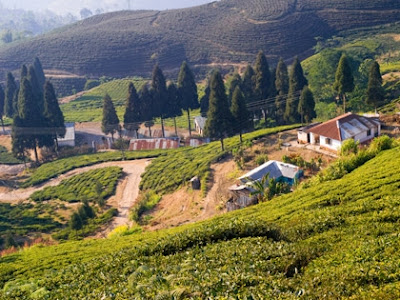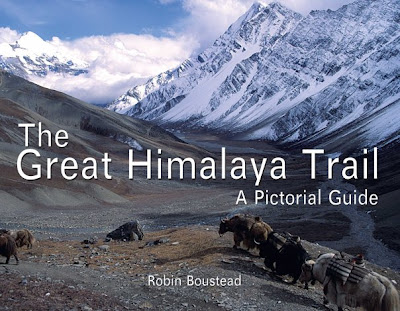The Next Really Big Thing: The Great Himalaya Trail
by Sue Badyari, CEO of World Expeditions
|
It has been called the Great Mother of All Treks: 4500 kilometers of twisting trail, the longest and most extreme in the world, brushing up against the world’s highest peaks, through verdant terraced fields, across halucinatory plateaus, over postcard passes, and dropping in on some of the most remote communities on Earth. It's the Great Himalaya Trail. |
|


Great Himalaya Trail, Stage 1
The Great Himalaya is the vertiginous uplift of the Main Central Thrust at the convergent boundary between the Eurasian and Indo-Australian tectonic plates. It stretches 2500 kilometers from Nanga Parbat (8,126 m/ 26,660 ft) on the Indus River in Pakistan to Namche Barwa (7782 m/ 25,531 ft) towering over the Tsangpo in Tibet. The plan is to define and promote a continuous network of trails, and already --thanks to Robin Boustead -- travelers have completed the first leg of the inaugural traverse of Nepal.

Himalayas map courtesy of Wikipedia
The Nepal section of the GHT runs from Kanchenjunga (8586 m/28,169 ft) in the east to Saipal (7031 m/23,068 ft) in the west. Since 2008, Robin Boustead has researched and mapped the 3500 km trail network in Nepal, focusing on two routes. "The High Route," he explains, "is the highest feasible route that joins each himal, or peak cluster; the less extreme Cultural Route skirts the southern slopes of each himal. In time I hope to document enough of the Cultural Route options so this could be a self-guided trail network, but the High Route will always require support crews."
Makalu Sherpani Col
As architect of the GHT, Robin had two objectives in mind. First, he wanted to offer trekkers an extreme adventure. Long-distance "thru-hiking" (also known as "end-to-end hiking" or "end-to-ending") has become increasingly popular in the United States, especially on the Appalachian Trail, the Pacific Crest Trail and the Continental Divide Trail. A variant option, referred to "section hiking," entails completing a long trail by hiking all of its sections, but not at one go, and not necessarily in sequence. Robin felt that Nepal had the ideal topography for both thru-hiking and section-hiking. More importantly, a long-distance trail would offer travelers contact with a variety of traditional cultures that had not already experienced the kind of commodification and homogenization typical of the Big Three destinations in Nepal: Annapurna, Everest, and Langtang.

Robin Boustead, architect of the Great Himalaya Trail project
Secondly, Robin realized that the vast majority of Nepalis were missing out on the economic opportunities offered by tourism. The concentrated impact of wealthy travelers in a few areas results in locally inflated prices for many foodstuffs, fuel, and building materials, to the point that they are beyond the reach of those members of the community who do not have a direct stake in the tourist trade. Away from the trekking routes, subsistence farmers may have no access at all to a cash market, and they also lack much of the infrastructure that accompanies tourism development, including clinics, well-engineered bridges, schools, and electricity. Robin believes that the introduction of a new stream of tourism over a much longer network of destinations will alleviate somewhat the extreme poverty of a large number of communities without causing the economic and cultural distortions that are typically associated with full-on tourism development.
We at World Expeditions are immensely proud that Robin Boustead agreed to lead the first group of trekkers over the easternmost leg of newly defined GHT in Nepal. A few days ago he surfaced in Kathmandu after a highly successful trek (including a lunch-time encounter with a snow leopard on the way to Lhonak in the Kanchenjunga Conservation Area). Now Robin is off to research the GHT in northen India, to the west of Nepal, and world-famous climber Stephen Venables is leading the 34-day second stage of the our GHT expedition, Makalu & Everest Traverse via Sherpani Col (13 Mar - 15 Apr).
Of course, there is a delicate balance to be achieved in managing the GHT High Trail expeditions so as not to introduce a measure of economic opportunity without compromising the environment and culture of remote regions. In a future article, I'll explain our "responsible tourism" practices, and in particular our cutting-edge "carbon neutrality" program.
Langtang Tamang people
Meanwhile, for more information about the Great Himalaya Trail, you might want to consult Robin Boustead's two new books. In late 2009, Robin published a large format lavishly illustrated volume titled The Great Himalayan Trail: A Pictorial Guide. The book opens with "The Great Himalaya Trail Code" which Robin wrote in collaboration in the International Center for Integrated Mountain Development (ICIMOD). In addition to providing an enticing preview of what you will see for yourself on the trail, this book summarises Robin's ambitious hopes and visions for developing the trail.

Last November Robin published a detailed guidebook, Nepal Trekking & the Great Himalaya Trail, available from Trailblazers.

Online, you will find maps and in-depth information at http://thegreathimalayatrail.org/
You can follow the inaugural GHT expedition at on our blog, and you'll find full details about Responsible Tourism, the GHT, and all our programs at the World Expeditions Web site.
Unless otherwise noted, photos courtesy of Robin Boustead and World Expeditions
Seth Sicroff is the Nepal Editor for Wandering Educators

